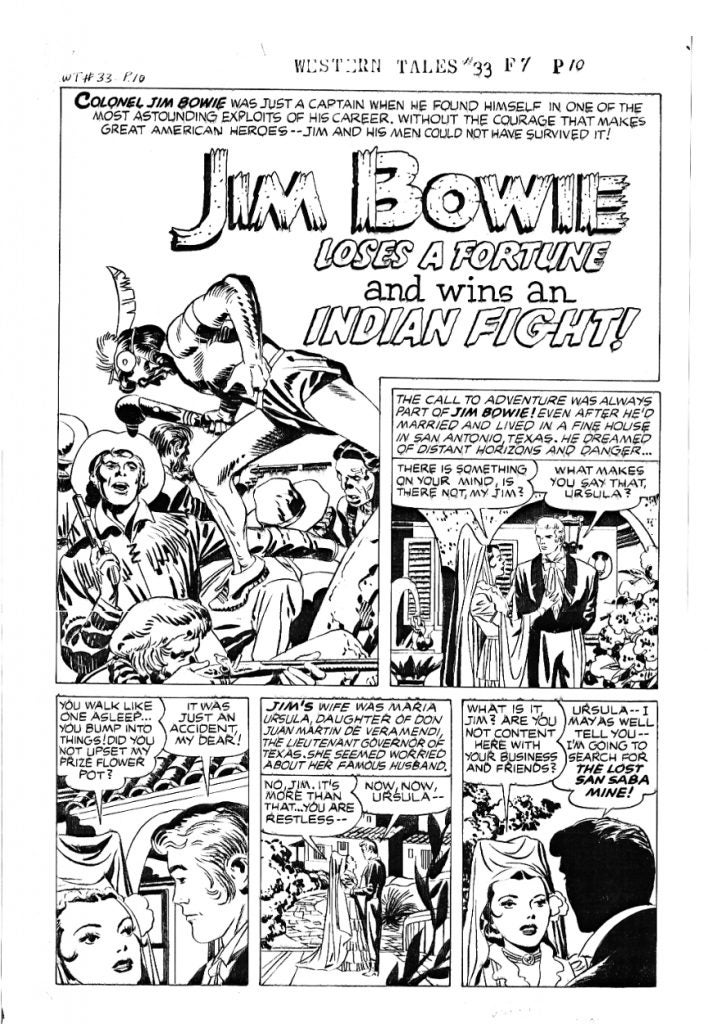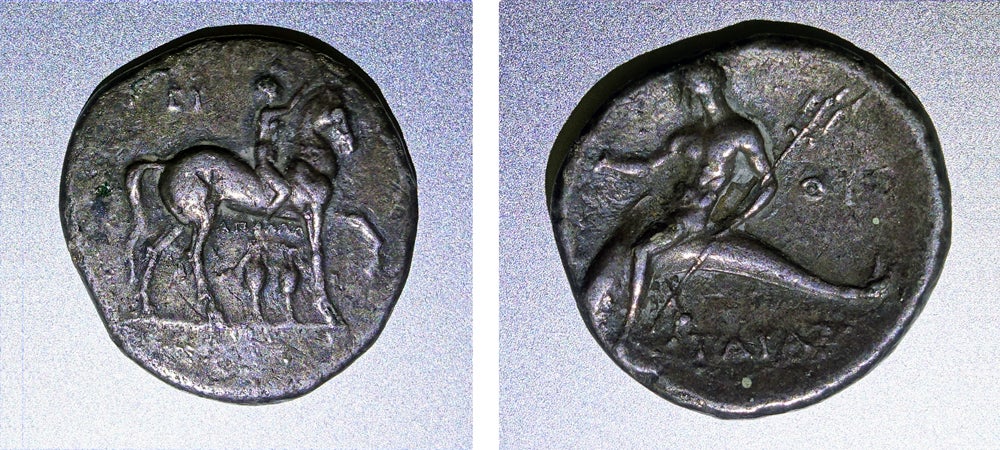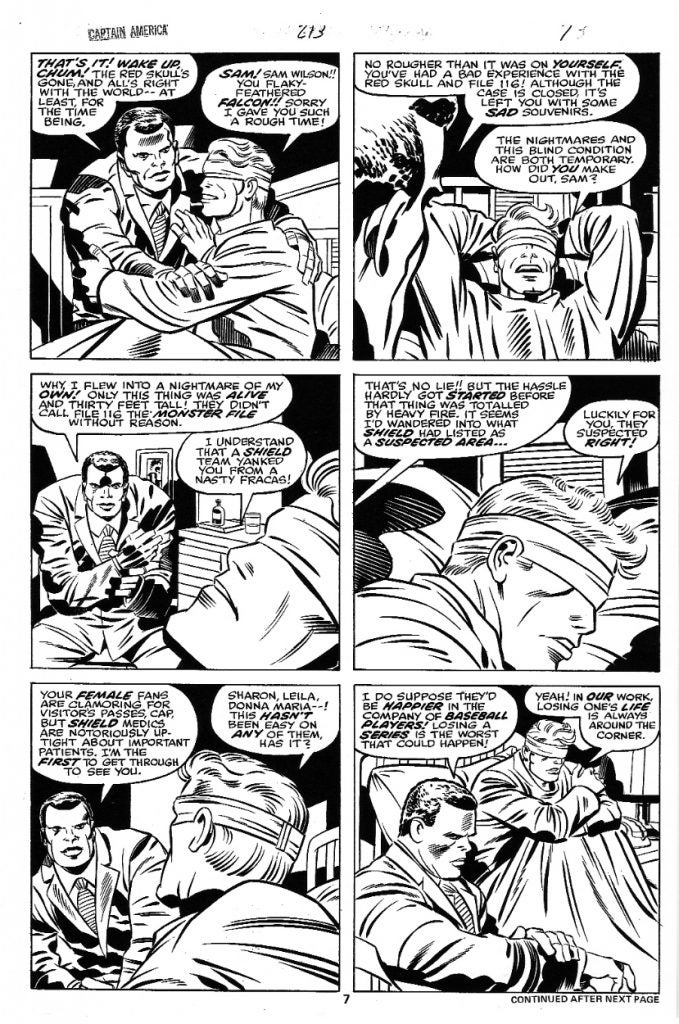 Persian Ring with Deep Red Carnelian Stone (ca. 1750 CE)
Persian Ring with Deep Red Carnelian Stone (ca. 1750 CE)
Silver and Gold, niello inlay, 20.5 mm diameter
Carved intaglio stone with birds and deer; bezel 26.6 mm x 23.00 mm x 9.8 mm
17.00 grams weight
Coppola Collection
Signet pressed into wax:

 Brian P Coppola
Brian P Coppola
 Persian Ring with Deep Red Carnelian Stone (ca. 1750 CE)
Persian Ring with Deep Red Carnelian Stone (ca. 1750 CE)
Silver and Gold, niello inlay, 20.5 mm diameter
Carved intaglio stone with birds and deer; bezel 26.6 mm x 23.00 mm x 9.8 mm
17.00 grams weight
Coppola Collection
Signet pressed into wax:


Grendel #16 Interlude p 2 (1988)
By Matt Wagner (1961-)
13 x 17 in, acrylic on paper
Coppola Collection
In between Mage: The Hero Discovered (Feb 1984 – Dec 1986) and Mage: The Hero Defined (Jul 1997 – Oct 1999), creator Matt Wagner published two Interlude stories. The first of these, a 24-page story, ran serially for 4 issues as a backup in Grendel #16-19 (Jan-Apr 1988).
This is the second page from the first part of the story, told in French, in which Etienne and Marie rendezvous. Etienne becomes a horse from a sculpture in the fountain.
Things get steamy, then things get weird.
More “work” at Nanjing University (July 2018)

The Nanjing Teaching Team: Hui Zhang (staff assistant), John Henssler (NYU), Chengjian Zhu (Nanjing U), moi, JP Desaulniers (UOIT), Ed Palermo (RPI)
Me and my class at Nanjing U
Working with a student at the boards
Visit to the Imperial Testing Center
Making a point, apparently.

Western Tales 33 p 10 (September 1956)
by Jack Kirby (1917-1994) and Joe Simon (1913-2011)
13 x 20 in., ink on paper
Coppola Collection
The world while I was gestating!
“Jim Bowie Loses a Fortune and Wins an Indian Fight”
Jack Kirby and Joe Simon had a long partnership that ran from 1940-1956. They wrote their own stories, with Kirby working on pencils/lay-outs and Simon doing the inking (and taking care of the business).They gained the most fame as the creators of “Captain America” for Timely in 1941.
In the early 1950s, Harvey Publishers had a horror title called “Witches Tales” that ran for 28 issues (Jan 1951 – Dec 1954). The title was relaunched as “Witches Western Tales” in 1955, featuring 1-2 original Kirby/Simon stories along with reprints from some of their earlier Harvey work (e.g., “Boys’ Ranch” 1, 3-6 from 1950-51).
“Witches Western Tales” ran for two issues (#29 Feb 1955 and #30 Apr 1955) and was retitled to “Western Tales” for three more issues (#31 Oct 1955, #32 Jan-Mar 1956, and #33 Jul-Sep 1956).
This is the title page from the second original story in that final issue (“Jim Bowie Loses a Fortune and Wins an Indian Fight”) and it probably represents one of the last Kirby-Simon collaborations during the time of their original partnership, prior to a brief 1959 reunion for two hero stories published by Archie Adventure Comics.
I have all 5 pages of this story.

Western Tales 33 p 11 (September 1956)
by Jack Kirby (1917-1994) and Joe Simon (1913-2011)
13 x 20 in., ink on paper
Coppola Collection

Western Tales 33 p 12 (September 1956)
by Jack Kirby (1917-1994) and Joe Simon (1913-2011)
13 x 20 in., ink on paper
Coppola Collection

Western Tales 33 p 13 (September 1956)
by Jack Kirby (1917-1994) and Joe Simon (1913-2011)
13 x 20 in., ink on paper
Coppola Collection

Western Tales 33 p 14 (September 1956)
by Jack Kirby (1917-1994) and Joe Simon (1913-2011)
13 x 20 in., ink on paper
Coppola Collection

Tales of Suspense 86 p 11 (February 1967)
by Gene Colan (1926-2011) and Frank Giacoia (1924-1988)
13 x 20 in., ink on paper
Coppola Collection
Fifty Years Ago!
“Death Duel For the Life of Happy Hogan”
Nostalgia kicked up a notch or ten. This original art is from one of the first two Marvel comics I ever bought, and the publication date is the month I turned 10 years old. It would have been inconceivableto think about owning one of these pages. Twenty-something years later, I picked it up. Today, you cannot come near this kind of stuff.
The entire story is nearly fully encapsulated on this page: having kidnapped Happy Hogan (thinking that he is Iron Man) the Mandarin is about to execute him when the real Iron Man arrives to stop him.
After a pitched battle, Iron Man manages to fight off his foe. As he’s rescuing Happy Hogan from the Mandarin’s soldiers, Iron Man learns that they have altered the course of a test missile being launched in Peking to target the United States.
Iron Man redirects the missile to the Mandarin’s castle, and escapes with Happy, and the Mandarin is seemingly killed in the explosion.
 Taras or Tarentum, in Calabria, Southern Italy (300-280 BCE)
Taras or Tarentum, in Calabria, Southern Italy (300-280 BCE)
Naked boy on horseback crowning horse with wreath, Taras Anked, Riding on Dolphin with Trident
6.13 g silver AR didrachm, 22 mm
Provenance: Historical Real Treasures (Agustin A Garcia B – ANA R-3120473)
Coppola Collection
Unconfirmed information: “very hard to find; Vlasto 766 (same dies) KO-785”
I cannot find an image of the Vlasto reference. The closest I have found so far is this one, and it is pretty close, so “very hard to find” might well be true.
Tarentum, Calabria AR Didrachm. 281-272 BC. Youth on horseback right raising hand, CY above, AΠOΛΛΩ (“Apollo”) and two amphorae below / Taras riding on dolphin left, holding trident, B to right, TAΡAΣ (“Taras”) below.
Reference: SNG Cop 891var

The ancient Greek colonies spread to Italy, the Mediterranean islands, Syria, Egypt and the Middle East. One of the more successful colonies was one founded by refugees from Sparta on the southern end of the Italian peninsula in about 700 B.C. Named Taras, it flourished for nearly 500 years before it was destroyed by the Romans c. 207 B.C.
A popular story about the founding of the city involves dolphins. In 708 B.C. a group of Spartan refugees, following the instruction of the oracle at Delphi (whose name comes from the word for dolphin, and who is the sacred oracle of Apollo, whose symbol is the dolphin), set sail toward the southern end of the Italian peninsula to found a colony there. It’s said that Phalanthos, the leader of the Spartan colonists, was shipwrecked before reaching land, but was saved by a dolphin that carried him to the shore. The tale echoes the popular Greek myth of Taras, son of Poseidon who was also saved from shipwreck by a dolphin. The city that was founded there was named Taras, in his honor, and the city’s patron was Apollo, thus it was a natural that the symbol of the city would be a boy riding a dolphin.
The colony of Taras was founded at the point that offers the first safe harbor on the Mediterranean after one leaves Greece. This put it in the perfect geographical spot to become a major trading center, and it did. Its position at the very heel of the boot allowed it to control both the outer bay for sea-going vessels, and the inner port, flowing into the river inland further into Italy. Between the need for coin for merchant trading and for paying mercenaries who protected the city from invaders, the city of Taras was one of the most prolific producers of coinage in the middle centuries of the Greek empire.
The figure of a boy riding a dolphin is found on the front of most coins from Taras. The rider on horseback did not appear on the coins of Taras until about 450 B.C. From that period until about 200 B.C. when the city fell to the Romans, there were many different versions of the horseback reverse on various coins in many denominations.
 Captain America 213 p 7 (September 1977)
Captain America 213 p 7 (September 1977)
by Jack Kirby (1917-1994) and Dan Green (ca. 1946-)
13 x 20 in., ink on paper
Coppola Collection
“The Night Flyer!”
After dreaming that he is fighting the Red Skull, Captain America awakens, still blind, in the hospital. The Falcon, whom a SHIELD team rescued in South America killing “Big Bird,” is by his bedside.
Jack Kirby and Stan Lee … or Stan Lee and Jack Kirby … launched the modern age of superheroes in 1961 with their naturalistic approach to the Fantastic Four. This history is written. Kirby was with the company from 1958 to 1970, when the stress of creative differences split him from Lee and the growing monolith of the Marvel Comics Group.
His separation was a hiatus, and he returned to Marvel from DC from 1976-78, writing and drawing his co-creation with Joe Simon, “Captain America,” from issues 193-214, this page being from Kirby’s penultimate issue before his permanent split from the mainstream comics companies in 1978.
His art still had the same blocky power, but it always felt a little off compared with the work in the 1960s. And, heretical or not, the guy could not write. He was used to providing margin notes of ideas in his art, which Lee or other writers would turn into actual script dialogue that seemed more situated in the modern world.
This page starts off with the memorable “That’s It! Wake Up, Chum!” and pretty much goes downhill from there.
An email exchange from this morning:
“What are you doing this summer?”
“Right now I am in the middle of a 5-week stint in China — so greetings from Shanghai!”
“Too cool. Work or play?”
“Honestly, and I know I am totally annoying when I say this, but I really do not even understand that question.”
“Shit. I walked right into that one. I want your job.”
“What is this thing called ‘job’ of which you write?”
“And, fuck you, too.”





Pair of Kraak plates, table motif
Recovered from the Wanli shipwreck (ca. 1625) by Sten Sjostrand
each: 29.5 cm (11.5 in.) in diameter
Provenance: Nanhai Marine Archeology (Sjostrand Collection)
Coppola Collection
In the year 1625, a Portuguese vessel set off from China on a voyage to the Straits of Melaka. Onboard were tons of chinaware and pottery that would bring lucrative profits for the Portuguese.
However, the ship now named “Wanli” never reached the Portuguese fort of Melaka as she sank half way sailing through the South China Sea. The wreckage was discovered buried deep in the ocean off the coast of Terengganu, together with her precious cargo, six miles off the east coast of Malaysia after pottery appeared in fishermen’s nets in 1998.
The ship was found six years later, loaded with blue and white antique Chinese porcelains belonging to the Ming Dynasty, the ruling dynasty of China from 1368 to 1644. The vessel became known as the Wanli shipwreck after the recovered ceramic was assigned to Guangyinge site in the town of Jingdezhen during the reign of Emperor Wanli (1573-1620).
Kraak porcelain (Dutch Kraakporselein) is a type of Chinese export porcelain produced mainly from the Wanli reign (1573–1620). It was among the first Chinese export ware to arrive in Europe in mass quantities, and was frequently featured in Dutch still life paintings of foreign luxuries.
Strictly defined, it “is distinguished by the arrangement of its ornament into panels; these usually radiate to a bracketed rim notorious for its liability to chip.” It is mostly made as deep bowls and wide dishes, decorated with motifs from nature, in a style not used on wares for the domestic Chinese market.
The term Kraak porcelain is thought to be derived from the Portuguese ships (Carracks) in which it was transported.
Kraak ware is almost all painted in the underglazed cobalt blue style that was perfected under the Ming dynasty.
These are one of two unusual and pristine pairs that were part of the archeologists personal collection. He has the other pair.
For more about Shipwreck stoneware and porcelain, see here.
 “Not Brand Echh” #5 p 3 (December 1967)
“Not Brand Echh” #5 p 3 (December 1967)
by Gene Colan (1926-2011)and John Tartaglione (1921-2003)
13 x 20 in., ink on paper
Coppola Collection
Fifty Years Ago!
Marvel Comics’ superhero-satire comic book “Not Brand Echh” ran for 13 issues (cover-dated Aug. 1967 – May 1969). The series title was a play on an advertising convention of the time, in which a competitor’s product was not referred to by name, but simply as “Brand X.”
Rival and then-dominant comics company DC was sometimes playfully called “Brand Echh” in Marvel letters pages, hence this comic was “Not Brand Echh.”
This page is from “The Revengers Vs. Charlie America,” which satirizes the bellweather events of Avengers #4 when the four remaining original Avengers discovered Captain America floating in a block of ice, marking his return to the modern age of comics from the WWII era.